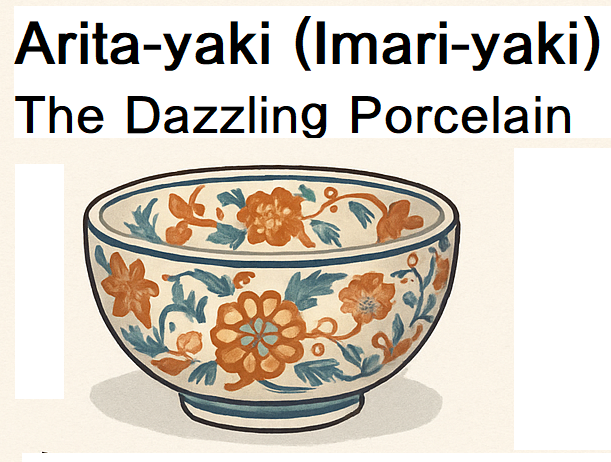
Arita-yaki, also known internationally as Imari porcelain, is a renowned type of Japanese porcelain produced primarily in Arita Town, Saga Prefecture.
Its hallmark is the luxurious and colorful overglaze painting on pristine white porcelain, a style that has captivated both domestic and international admirers for centuries.
The Origins and History of Arita-yaki
Arita is celebrated as the birthplace of porcelain in Japan.
During the late 16th century, following the Japanese invasions of Korea, Korean potter Yi Sam-pyeong was brought to Japan.
After years of searching, he discovered high-quality kaolin clay in the Izumiyama quarry in Arita.
By 1616, Japan’s first porcelain production had begun, marking a new chapter in Japanese ceramics.
In the Edo period, Arita porcelain became a vital export commodity.
With China’s porcelain exports restricted due to internal policies, European demand shifted to Japan.
Arita kilns flourished, producing masterpieces that imitated and eventually rivaled Chinese Jingdezhen porcelain.
One of the most notable styles to emerge from Arita is the Kakiemon style, created by Sakaida Kakiemon I.
This style features vivid overglaze painting on a milky white body, known as “nigoshi-de,” and is famous for its refined aesthetic and balanced use of empty space.
The influence of Arita porcelain extended worldwide, inspiring European porcelain manufacturers such as Meissen.
Arita-yaki and Imari-yaki: What’s the Difference?
The terms Arita-yaki and Imari-yaki are often used interchangeably, but there are subtle distinctions.
Historically, all porcelain made in the Hizen region, which includes today’s Arita and Imari, was shipped from the port of Imari.
Thus, even porcelain produced in Arita was called “Imari” once it was shipped overseas or to other domestic markets.
Today, Arita-yaki generally refers to porcelain produced in Arita Town, while Imari-yaki can also refer specifically to high-grade porcelain like Nabeshima ware, crafted in nearby Imari City for feudal lords and the imperial court.
This complex history explains why Arita-yaki and Imari-yaki are often confused.
The Modern World of Arita-yaki
Today, Arita continues to thrive as a center of porcelain production.
It produces everything from luxurious artworks to everyday tableware and even industrial ceramics such as tiles and acid-resistant products.
Traditional techniques are preserved through designated master artisans, and innovative collaborations with modern industries and pop culture brands are expanding Arita-yaki’s appeal.
Each year during Golden Week, the Arita Pottery Fair attracts nearly a million visitors, offering a chance to explore a dazzling array of traditional and modern porcelain at special prices.
Discover Arita’s Rich Legacy
Arita-yaki is not just about beautiful objects—it tells a story of craftsmanship, resilience, and cultural exchange.
When you visit Arita, you’ll walk through historic streets lined with old kilns and charming pottery shops, each offering unique treasures.
Take your time to find that special piece that resonates with you—an authentic gem of Japanese tradition.
有田焼(伊万里焼)について
有田焼は、日本の佐賀県有田町を中心に生産される磁器です。この焼き物は、純白の白磁と、華やかで多彩な色絵付けを特徴とし、日本国内はもとより海外でも高級磁器として高い評価を受けています。
有田焼と伊万里焼の違い
有田焼は時に伊万里焼とも呼ばれますが、両者には微妙な違いがあります。江戸時代、有田で作られた磁器は陸路で運ばれる一方、伊万里港を経由して海路で出荷された磁器には「伊万里焼」という名称が付けられました。そのため、伊万里焼には有田産の磁器が含まれることもあります。今日では、有田町で作られる磁器を有田焼、伊万里市で作られる磁器を伊万里焼と呼ぶことが一般的です。なお、伊万里焼は特に献上品に由来する高級磁器「鍋島焼」の伝統を引き継いでいます。
有田焼の起源
有田焼の歴史は、豊臣秀吉による朝鮮出兵に遡ります。この遠征により、日本へ連れてこられた朝鮮人陶工たちが磁器製作技術を伝えました。中でも李参平は、有田の泉山でカオリン鉱石を発見し、1616年に日本で初めて磁器を焼成することに成功しました。これにより、有田は日本磁器発祥の地となりました。
国際貿易と有田焼の発展
17世紀中頃、中国が海外貿易を制限すると、ヨーロッパ市場向けの磁器需要が有田に集中しました。有田では技術革新が進み、特に初代酒井田柿右衛門による「濁手(にごして)」と呼ばれる乳白色の素地に鮮やかな赤絵を施した柿右衛門様式が欧州で絶大な人気を博しました。明治時代には、有田焼は日本の重要な輸出品となり、海外の万国博覧会でも高く評価されました。
現代の有田焼
今日、有田焼は国の伝統的工芸品に指定され、美術品から日常食器、さらにタイルや耐酸磁器といった工業製品に至るまで幅広く生産されています。伝統技術を守りながらも、アニメキャラクターや異業種企業とのコラボレーションなど新しい試みにも積極的に取り組んでいます。毎年ゴールデンウィークには、日本最大規模の有田陶器市が開催され、全国から多くの人々が訪れます。
まとめ
有田焼と伊万里焼は、共に肥前焼の伝統を受け継ぐ磁器ですが、その呼称や流通経路によって区別されるようになりました。現在も有田やその周辺地域には歴史ある窯元が点在しており、訪れる人々を魅了し続けています。ぜひ、有田焼の窯元を巡り、あなただけの一品を探してみてください。
